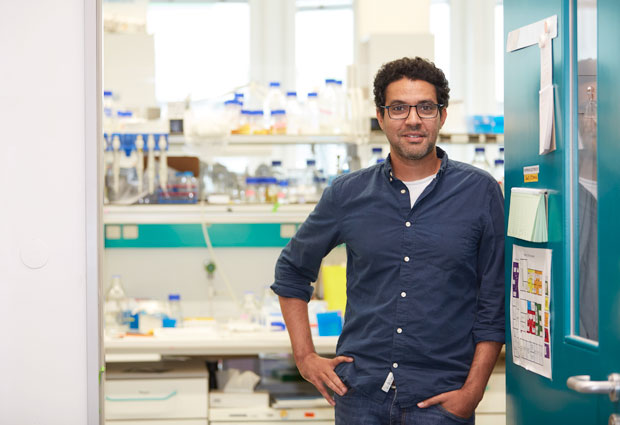
Welcome: Aissam Ikmi
New EMBL group leader studies sea anemones to investigate why some animals regenerate better than others

As part of the Developmental Biology Unit, new group leader Aissam Ikmi will lead research into how environmental factors and genetics shape the unusual bodies of the sea anemone, including their ability to regenerate lost tentacles.
How did you first become interested in science?
Growing up in Morocco, I was addicted to science documentaries and fascinated by the way life was visualised at varying scales: from the level of individual cells up to whole organisms. When I went to France to do my undergraduate studies, I knew I loved biology. But it was not until I opened a developmental biology textbook and saw a picture of a normal-looking fly alongside a mutant fly that had four wings instead of two that I knew I would become a biologist. I was hooked, eager to understand how animals are built and how genes and other factors control their development and the genetic programs that give rise to the huge range of shapes that we see in nature.
What is your group working on?
We study the starlet sea anemone, Nematostella vectensis, to understand how the interaction between genetic factors and the environment control developmental processes in animals. By altering their environment in different ways, we investigate how the animals alter their bodies in response. In particular, we focus on changes that occur at the cellular level.
The spectacular ability of sea anemones to regenerate is amazing
For example, the number of tentacles sea anemones have is controlled by how much food they eat. The more food they eat, the more tentacles they have. It’s not known exactly the maximum number of tentacles they are capable of growing – the most tentacles I have seen on Nematostella is 22. Food also controls the growth of their whole bodies, not just their tentacles, and their rate of sexual maturation – the more food sea anemones eat, the faster they’ll reach sexual maturity. They also respond to the oxygen level in their environment. If there is less oxygen in the seawater, their tentacles shrink.
Most notable in my research is the spectacular ability of sea anemones to regenerate – if you cut them in half, each half will grow into a new sea anemone! They’re particularly good animals for trying to find out why some animals are better at regeneration than others, which is a main focus of my lab.
Could you share an anecdote about working with sea anemones?
Unlike flies or mice, sea anemones are still relatively new in biomedical laboratory research. This means that the tools scientists have on hand to study flies or mice – tools to manipulate their genes, to make mutants, to label cells – are not yet well established for sea anemones. One day, while I was working on developing these tools in order to make future study on sea anemones possible, I discovered something strange.
I was testing electroporation, a method that helps biologists introduce DNA into a cell. In order to see if the electroporation worked, I tried to express a green glowing protein in the sea anemone. This fluorescent protein is widely used by biologists to mark and track certain cells in other animals. If the electroporation had worked, the animal I was working with should have glowed green. But instead of glowing green, the animal glowed red. When I did a negative control, to see how the electroporation without the fluorescent protein affected the animal, it glowed red again. So, the red light didn’t result from the introduced DNA.
In the end, I realised that all the fluorescent protein we use in the lab is extracted from jellyfish. Sea anemones, which are closely related to jellyfish in the animal family tree, also produce their own fluorescent protein. So, what I was doing was stressing the animal and seeing its natural response – the red glow actually came from the animal’s own proteins, not the ones I introduced.
I was hooked, eager to understand how animals are built and how genes and other factors control their development
Which scientific mystery keeps you up at night?
I’m fascinated by an idea expressed by the British developmental biologist Jonathan Bard, who said, “The behaviour of a cell in an embryo depends on the extent to which it listens to its mother or its neighbourhood.” To me, a cell’s neighbourhood means not only neighbouring cells but the surrounding environment, too. So a question that captivates me is, how do developing multicellular organisms respond to changes in their environment while simultaneously executing their genetic program? Their process of development needs to be both robust and plastic – a delicate balance that I would love to know more about.


